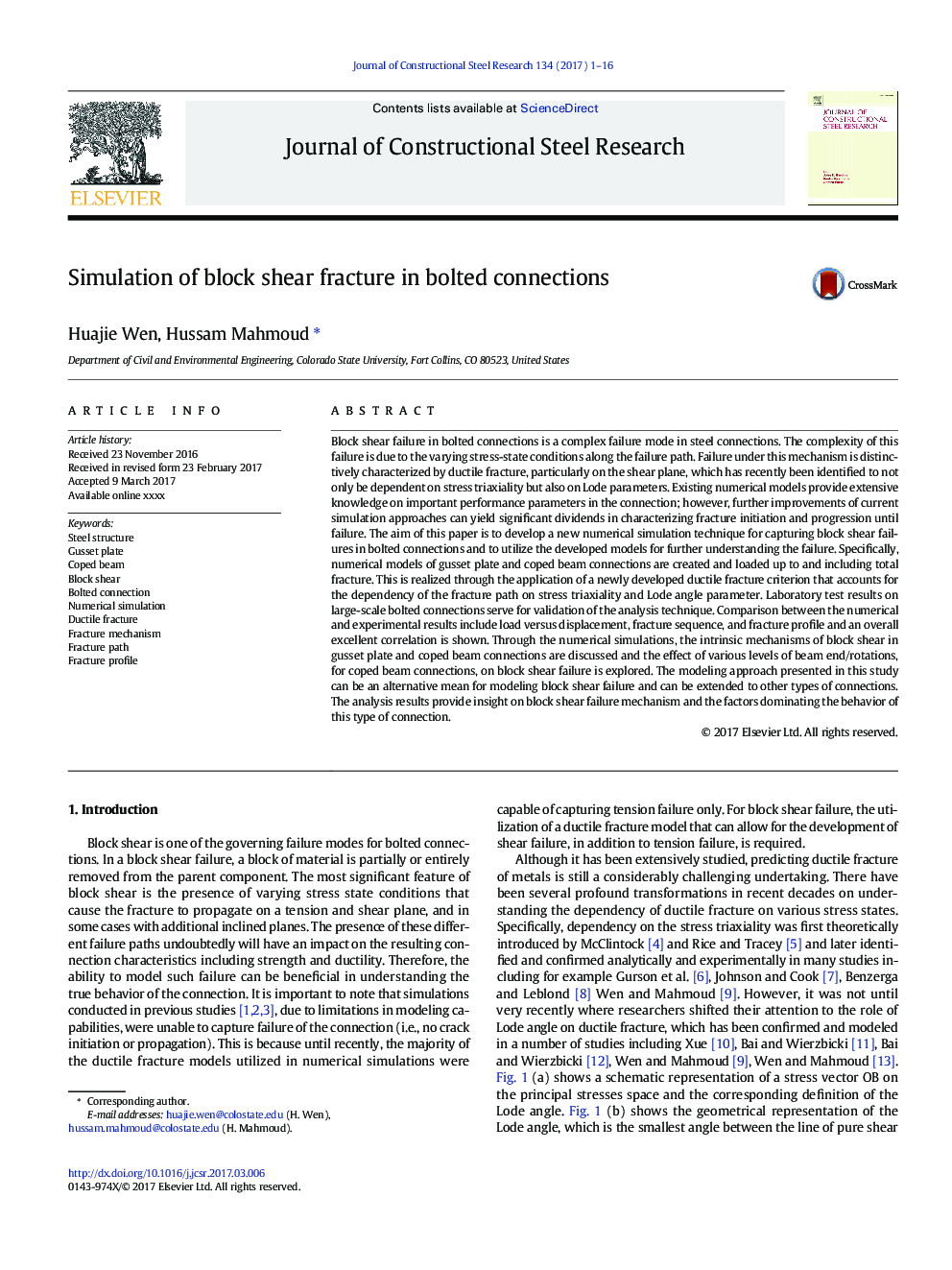| کد مقاله | کد نشریه | سال انتشار | مقاله انگلیسی | نسخه تمام متن |
|---|---|---|---|---|
| 4923414 | 1430696 | 2017 | 16 صفحه PDF | دانلود رایگان |
عنوان انگلیسی مقاله ISI
Simulation of block shear fracture in bolted connections
ترجمه فارسی عنوان
شبیه سازی شکست برشی بلوک در اتصالات پیچ و مهره
دانلود مقاله + سفارش ترجمه
دانلود مقاله ISI انگلیسی
رایگان برای ایرانیان
کلمات کلیدی
ترجمه چکیده
شکست شکست برشی در اتصالات پیچ و مهره یک حالت شکست پیچیده در اتصالات فولادی است. پیچیدگی این شکست ناشی از شرایط مختلف تنش در طول مسیر شکست است. شکست در زیر این مکانیسم به وضوح با شکستگی ورقه ای مشخص شده است، به خصوص در سطح برش، که اخیرا شناسایی شده است، نه تنها به سه بعدی بودن استرس، بلکه همچنین بر پارامترهای لید نیز وابسته است. مدل های عددی موجود، دانش گسترده ای را در مورد پارامترهای مهم عملکرد در ارتباط ارائه می کنند؛ با این حال، بهبود بیشتر رویکردهای شبیه سازی در حال حاضر می تواند سود سهام قابل توجهی را در مشخص کردن شروع شکستگی و پیشرفت تا شکست. هدف از این مقاله، توسعه یک تکنیک شبیه سازی عددی جدید برای گرفتن شکست برشی بلوک در اتصالات پیچ و مهره و استفاده از مدل های توسعه یافته برای درک بیشتر شکست است. به طور خاص، مدل های عددی پلاستیکی و اتصالات پرتو مقطع ایجاد و بارگذاری می شوند و شامل شکست کامل می شوند. این امر از طریق کاربرد یک معیار شکست جدید مجتمع شده انجام می شود که به دلیل وابستگی مسیر شکست به ترتیب استحکام استرس و پارامتر زاویه لود است. نتایج آزمون آزمایشگاهی در اتصالات پیچیده مقیاس بزرگ برای اعتبار سنجی از روش تجزیه و تحلیل استفاده می شود. مقایسه بین نتایج عددی و تجربی شامل بار در مقابل جابه جایی، توالی شکستگی و شکستگی و همبستگی کلی بسیار عالی است. با استفاده از شبیه سازی های عددی، مکانیزم های ذاتی بلوک برش در صفحات روغنی و اتصالات پرتو مقابله مورد بحث قرار گرفته و تاثیر سطوح مختلف انتهای پرتو / چرخش برای اتصالات پرتو بر روی شکست برشی بلوک مورد بررسی قرار گرفته است. رویکرد مدل سازی ارائه شده در این مطالعه می تواند یک روش جایگزین برای مدل سازی شکست برشی برشی باشد و می تواند به سایر انواع ارتباطات گسترش یابد. نتایج تجزیه و تحلیل ارائه بینش در مکانیزم شکست بلوک برشی و عوامل موثر بر رفتار این نوع ارتباط است.
موضوعات مرتبط
مهندسی و علوم پایه
سایر رشته های مهندسی
مهندسی عمران و سازه
چکیده انگلیسی
Block shear failure in bolted connections is a complex failure mode in steel connections. The complexity of this failure is due to the varying stress-state conditions along the failure path. Failure under this mechanism is distinctively characterized by ductile fracture, particularly on the shear plane, which has recently been identified to not only be dependent on stress triaxiality but also on Lode parameters. Existing numerical models provide extensive knowledge on important performance parameters in the connection; however, further improvements of current simulation approaches can yield significant dividends in characterizing fracture initiation and progression until failure. The aim of this paper is to develop a new numerical simulation technique for capturing block shear failures in bolted connections and to utilize the developed models for further understanding the failure. Specifically, numerical models of gusset plate and coped beam connections are created and loaded up to and including total fracture. This is realized through the application of a newly developed ductile fracture criterion that accounts for the dependency of the fracture path on stress triaxiality and Lode angle parameter. Laboratory test results on large-scale bolted connections serve for validation of the analysis technique. Comparison between the numerical and experimental results include load versus displacement, fracture sequence, and fracture profile and an overall excellent correlation is shown. Through the numerical simulations, the intrinsic mechanisms of block shear in gusset plate and coped beam connections are discussed and the effect of various levels of beam end/rotations, for coped beam connections, on block shear failure is explored. The modeling approach presented in this study can be an alternative mean for modeling block shear failure and can be extended to other types of connections. The analysis results provide insight on block shear failure mechanism and the factors dominating the behavior of this type of connection.
ناشر
Database: Elsevier - ScienceDirect (ساینس دایرکت)
Journal: Journal of Constructional Steel Research - Volume 134, July 2017, Pages 1-16
Journal: Journal of Constructional Steel Research - Volume 134, July 2017, Pages 1-16
نویسندگان
Huajie Wen, Hussam Mahmoud,
